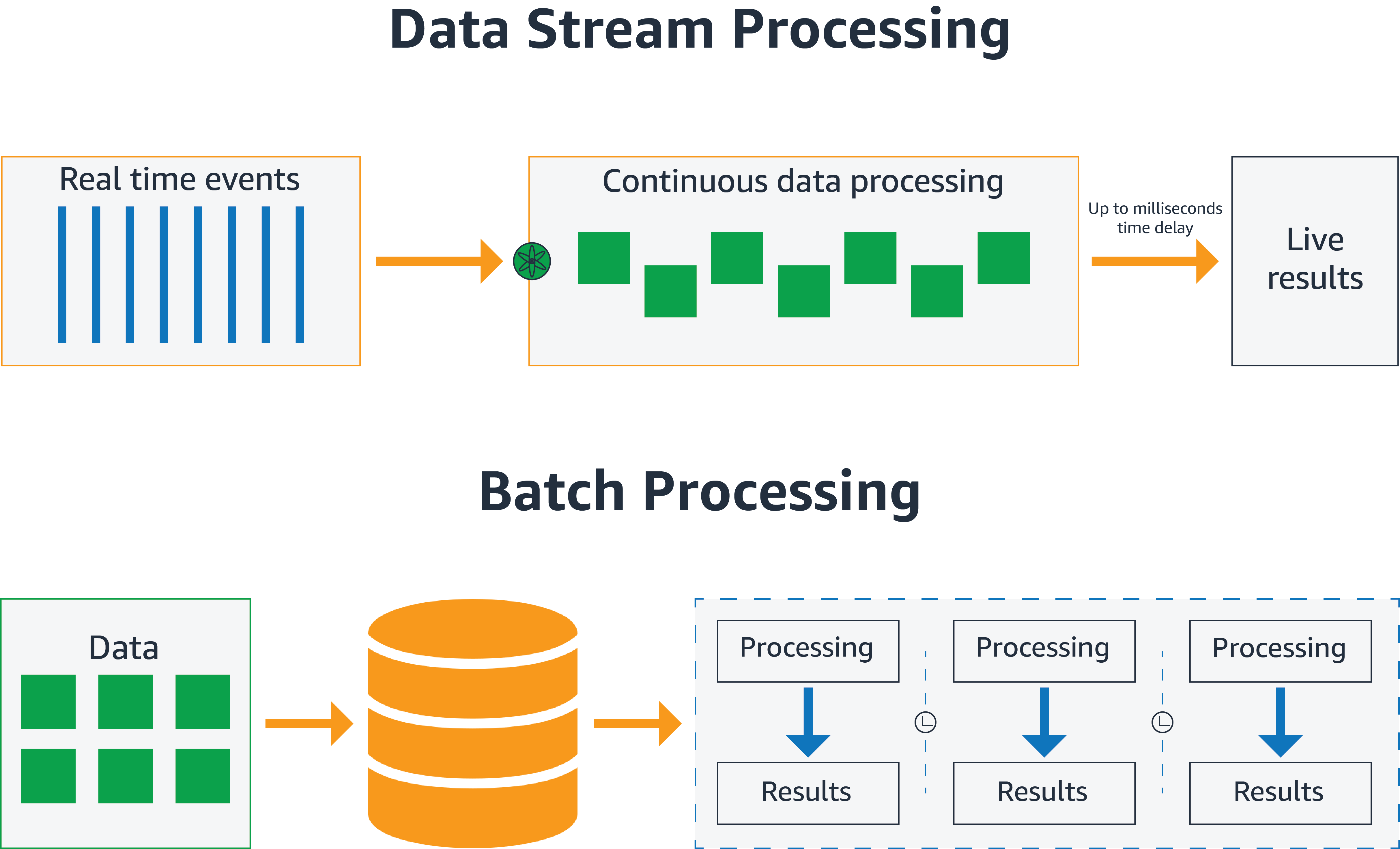In an era where data is the new oil, the speed
at which businesses can process and analyze this data becomes a critical
competitive advantage. Real-time data processing has emerged as a game-changer,
enabling organizations to make instant, informed decisions. This blog will
explore the power of real-time data processing, its benefits, and how
businesses can harness this technology to drive growth and efficiency.
Understanding
Real-Time Data Processing
Real-time data processing refers to the
capability to process data as soon as it is generated or received, without
significant delays. Unlike batch processing, where data is collected and
processed in bulk at scheduled times, real-time processing deals with data
streams continuously, providing immediate insights and responses. This
technology is underpinned by stream processing frameworks and event-driven
architectures that handle high-velocity and high-volume data with low latency.

Stream processing frameworks like Apache Kafka,
Apache Flink, and Apache Spark Streaming are at the heart of real-time data
processing. These platforms enable the ingestion, processing, and analysis of
data streams in real-time, supporting complex event processing and real-time
analytics. Scalability: Handle large volumes of data with horizontal scaling. Low Latency: Process and deliver data with minimal delay. Fault Tolerance: Ensure data integrity and reliability through
distributed architectures. Event-driven architecture (EDA) is a design
paradigm that uses events to trigger and communicate between decoupled
services. EDA is crucial for real-time data processing as it allows systems to
react to events as they occur, providing immediate responses. Asynchronous Processing: Handle multiple events concurrently without
blocking. Decoupling: Enable independent development and scaling of services. Real-Time Reaction: Respond to events instantaneously, enabling
real-time decision-making. In-memory computing solutions like Redis and
Apache Ignite store data in RAM rather than on disk, providing ultra-fast data
access and processing capabilities. This technology is essential for
applications requiring sub-millisecond response times. High-Speed Data Access: Achieve faster data retrieval and processing
by avoiding disk I/O. Reduced Latency: Minimize delays in data processing and
querying. Scalability: Support large-scale data sets with distributed in-memory storage. Real-time data processing empowers businesses
to make timely and informed decisions. By analyzing data as it arrives,
organizations can identify trends, detect anomalies, and respond to
opportunities or threats instantly. In sectors like e-commerce, finance, and
telecommunications, real-time data processing enhances customer experiences
through personalized interactions, immediate issue resolution, and proactive
service offerings. Real-time insights allow for the optimization
of operational processes. For example, in manufacturing, real-time monitoring
of equipment can predict failures before they occur, reducing downtime and
maintenance costs. Organizations leveraging real-time data
processing gain a significant edge over competitors. By reacting faster to
market changes and customer behaviors, businesses can innovate more rapidly and
capture market opportunities. In financial services, real-time data
processing is critical for algorithmic trading, fraud detection, and risk
management. By processing transactions and market data in real-time, financial
institutions can execute trades at optimal prices and detect fraudulent
activities instantaneously. E-commerce platforms use real-time data
processing to offer personalized recommendations, manage inventory dynamically,
and optimize pricing strategies. This leads to increased customer satisfaction
and higher sales conversion rates. Telecom operators utilize real-time data
processing for network optimization, real-time billing, and customer service
enhancement. This ensures efficient network performance and improved customer
retention. In healthcare, real-time data processing
supports patient monitoring, telemedicine, and predictive analytics. By
processing patient data in real-time, healthcare providers can deliver timely
interventions and improve patient outcomes. Identify the specific business scenarios where
real-time data processing can add value. Prioritize use cases based on their
potential impact on the organization. Example: An online retail company, ShopX, wants to
improve its customer experience and boost sales. By implementing real-time data
processing, ShopX can: Personalize
Customer Experience: Provide
real-time product recommendations based on the customer's browsing history and
current behavior on the site. If a customer is looking at running shoes, ShopX
can instantly recommend related items like socks, athletic apparel, or
accessories. Dynamic
Pricing: Adjust prices in real-time
based on demand, inventory levels, and competitor pricing. During a flash sale,
if a particular product is selling out quickly, ShopX can automatically raise
the price to optimize profit margins. Fraud
Detection: Identify
and block fraudulent transactions as they happen. By analyzing transaction
patterns in real-time, ShopX can detect anomalies such as multiple high-value
purchases from a single IP address within minutes. Prioritization: Given the potential for immediate revenue
impact and enhanced customer satisfaction, ShopX prioritizes real-time product
recommendations and dynamic pricing as their top use cases. Select appropriate stream processing
frameworks, event-driven architectures, and in-memory computing solutions that
align with your business requirements and technical capabilities. Example: A fintech company, FinSecure, needs to process
financial transactions in real-time to detect fraud and ensure compliance. Stream
Processing Framework:
FinSecure opts for Apache Kafka due to its robust message streaming
capabilities and scalability. Kafka can handle the high throughput of
transaction data and deliver it with low latency. Event-Driven
Architecture: To
build an event-driven system, FinSecure uses Apache Flink for real-time
analytics on the incoming transaction data. Flink's capabilities in complex
event processing (CEP) are crucial for detecting fraudulent patterns and
triggering alerts. In-Memory
Computing: For
quick data access and processing, FinSecure integrates Redis. Redis stores
critical transaction data in memory, enabling sub-millisecond latency for read
and write operations, essential for real-time fraud detection. Implement robust data governance practices to
ensure the accuracy, consistency, and reliability of real-time data streams. Example: A healthcare provider, HealthNow, relies on
real-time patient data from wearable devices to monitor patient vitals and
provide timely interventions. Data
Validation: HealthNow
uses a data validation pipeline to ensure incoming data from wearables is
accurate. For instance, if a heart rate reading is abnormally high or low, the
system flags it for further review before it affects decision-making. Data
Cleaning: HealthNow implements
automated data cleaning processes to handle missing or inconsistent data. If a
wearable device loses connection temporarily, the system fills in gaps using
interpolation techniques or flags the data for manual review. Data
Governance:
HealthNow establishes data governance policies that include regular audits and
monitoring of data quality metrics. They also use metadata management to keep
track of data provenance, ensuring the reliability of real-time health data. Continuously monitor the performance of your
real-time data processing infrastructure and optimize it to handle evolving
data volumes and complexities. Example: A telecommunications company, ConnectTel, uses
real-time data processing to manage network performance and ensure optimal
service delivery. Performance
Monitoring:
ConnectTel employs monitoring tools like Prometheus and Grafana to track key
metrics such as data throughput, latency, and error rates. This helps in
identifying bottlenecks and ensuring the system meets the required performance
standards. Scaling
Infrastructure: As
ConnectTel's user base grows, they scale their real-time processing
infrastructure using Kubernetes to manage and orchestrate containerized
applications. This allows them to dynamically allocate resources based on
current load and demand. Continuous
Optimization:
ConnectTel implements a feedback loop where performance data is analyzed to
optimize processing algorithms. For example, they might tweak the configuration
of Kafka brokers to handle peak traffic more efficiently or adjust Flink job
parameters for better resource utilization. Proactive
Alerts: By setting up proactive
alerts, ConnectTel can respond to issues before they impact customers. For
instance, if the latency in data processing spikes beyond a threshold, the
system automatically alerts the IT team to investigate and resolve the issue
swiftly. Real-time data processing is revolutionizing
how businesses operate, providing the agility and responsiveness needed in
today's fast-paced environment. By harnessing the power of real-time data,
organizations can drive innovation, enhance customer experiences, and achieve
operational excellence. Embrace this transformative technology to stay ahead in
the data-driven economy.
Key Technologies
Enabling Real-Time Data ProcessingStream
Processing Frameworks
Key
Features:
Event-Driven
Architecture
Key
Features:
In-Memory
Computing
Key
Features:
Benefits
of Real-Time Data Processing
Enhanced
Decision-Making
Improved
Customer Experience
Operational Efficiency
Competitive
Advantage
Real-World
Applications
Financial
Services
E-Commerce
Telecommunications
Healthcare
Implementing
Real-Time Data Processing
Define
Use Cases
Choose
the Right Technology Stack
Ensure
Data Quality
Monitor
and Optimize
Conclusion

Dot Labs is an IT
outsourcing firm that offers a range of services, including software
development, quality assurance, and data analytics. With a team of skilled
professionals, Dot Labs offers nearshoring services to companies in North
America, providing cost savings while ensuring effective communication and
collaboration.
Visit our website: www.dotlabs.ai, for more information on how Dot
Labs can help your business with its IT outsourcing needs.
For more informative Blogs on the latest technologies and trends click here



